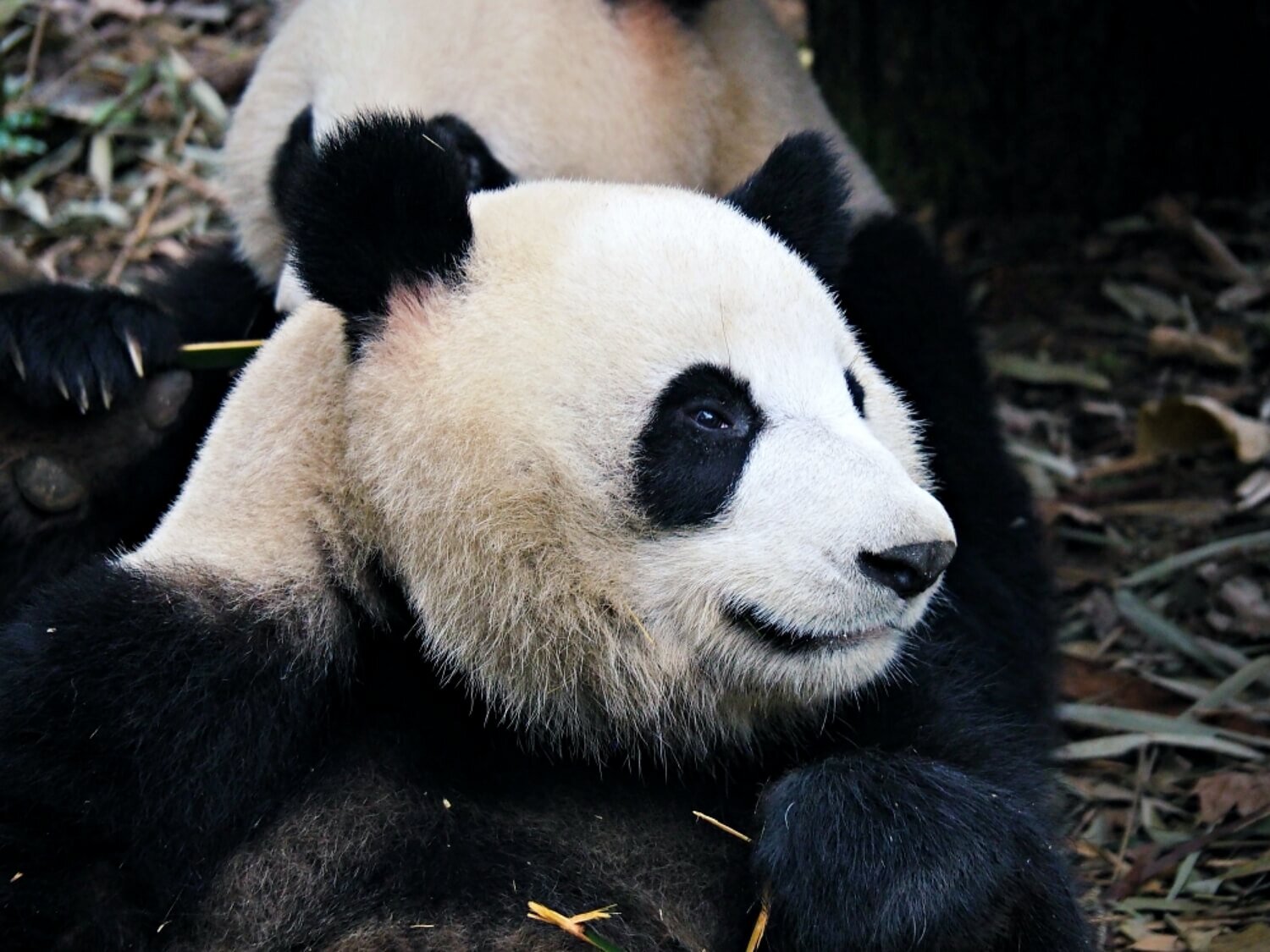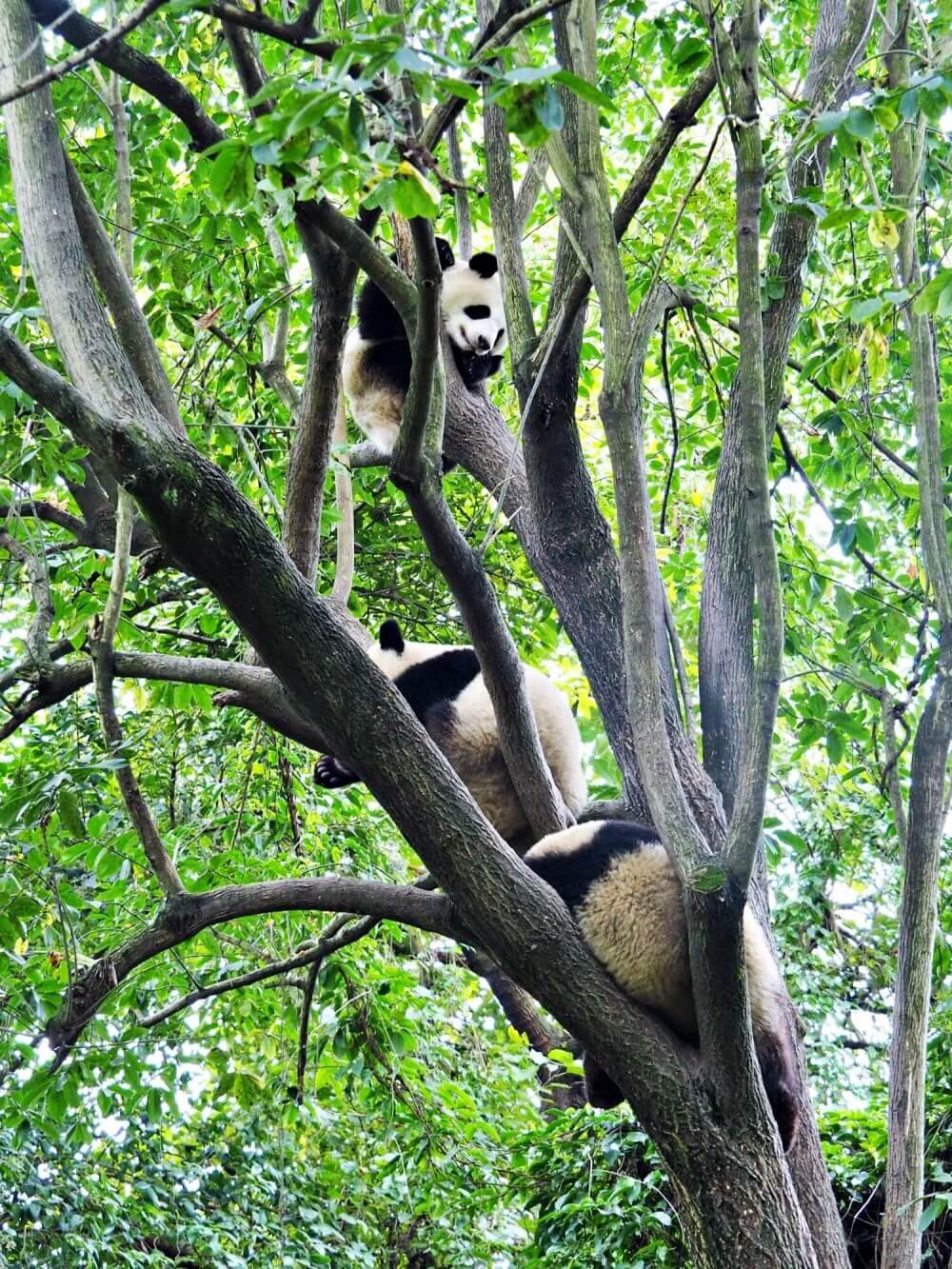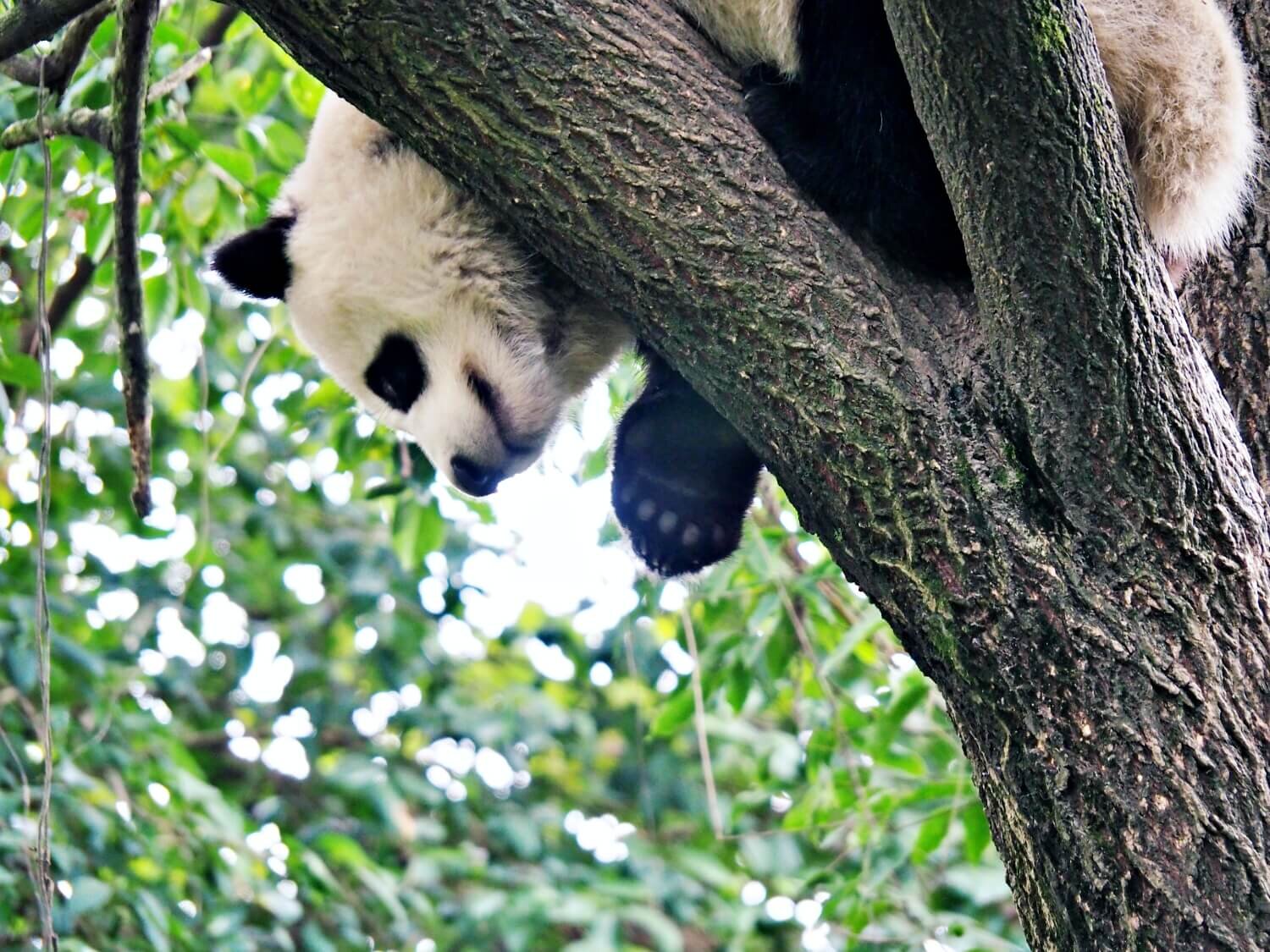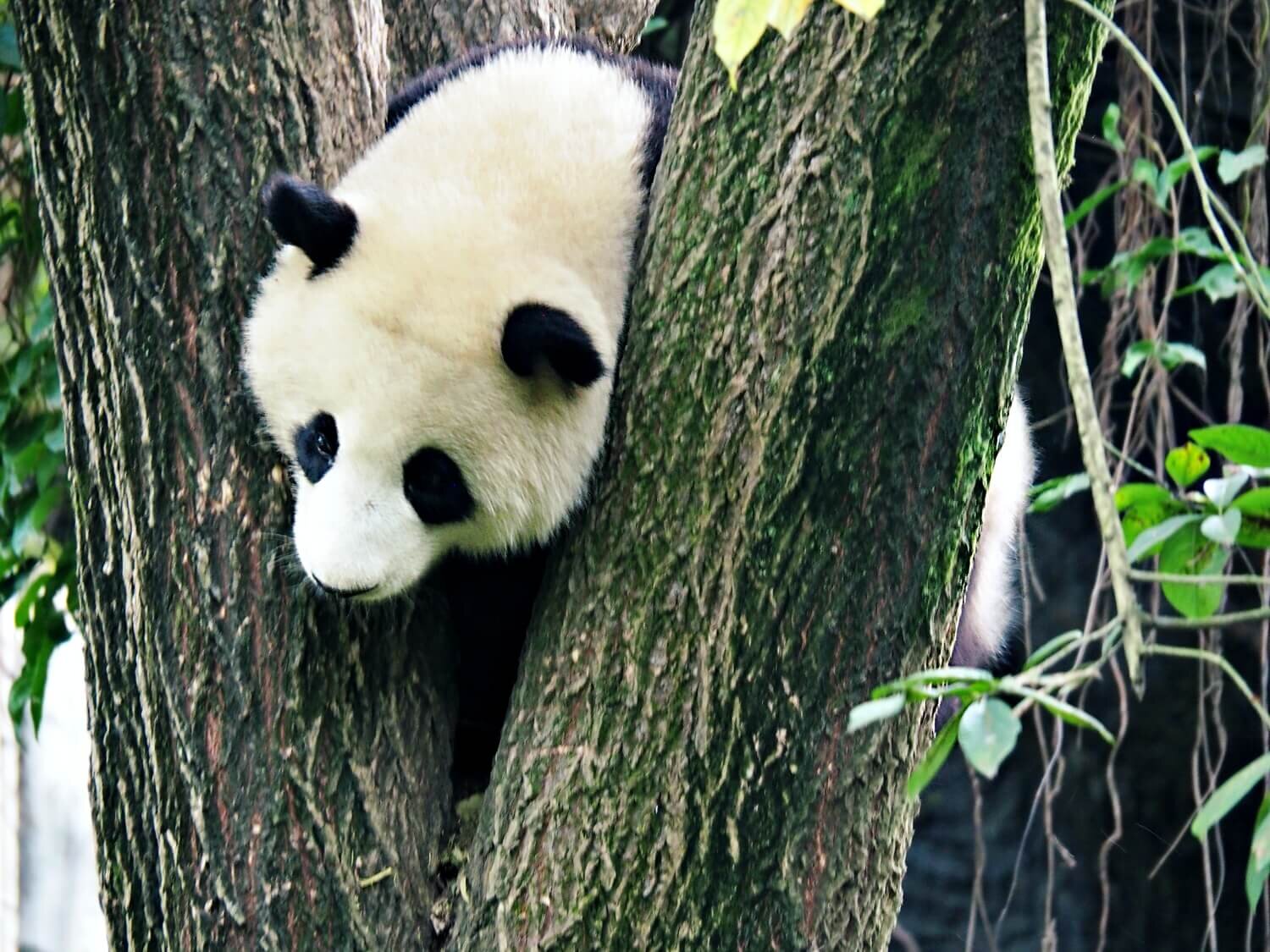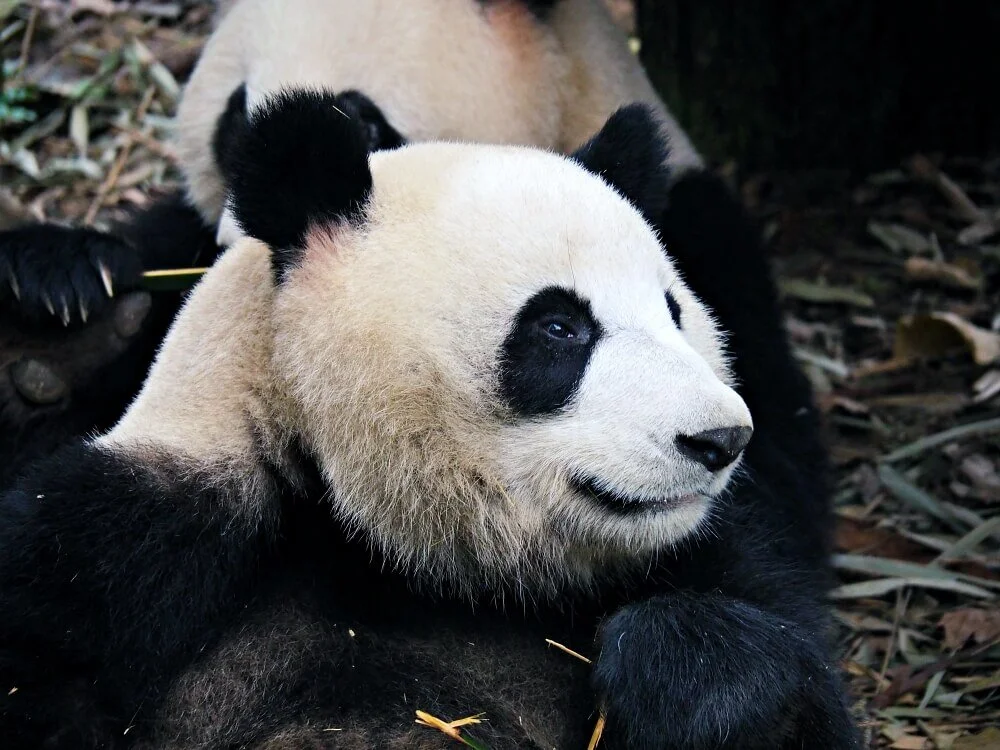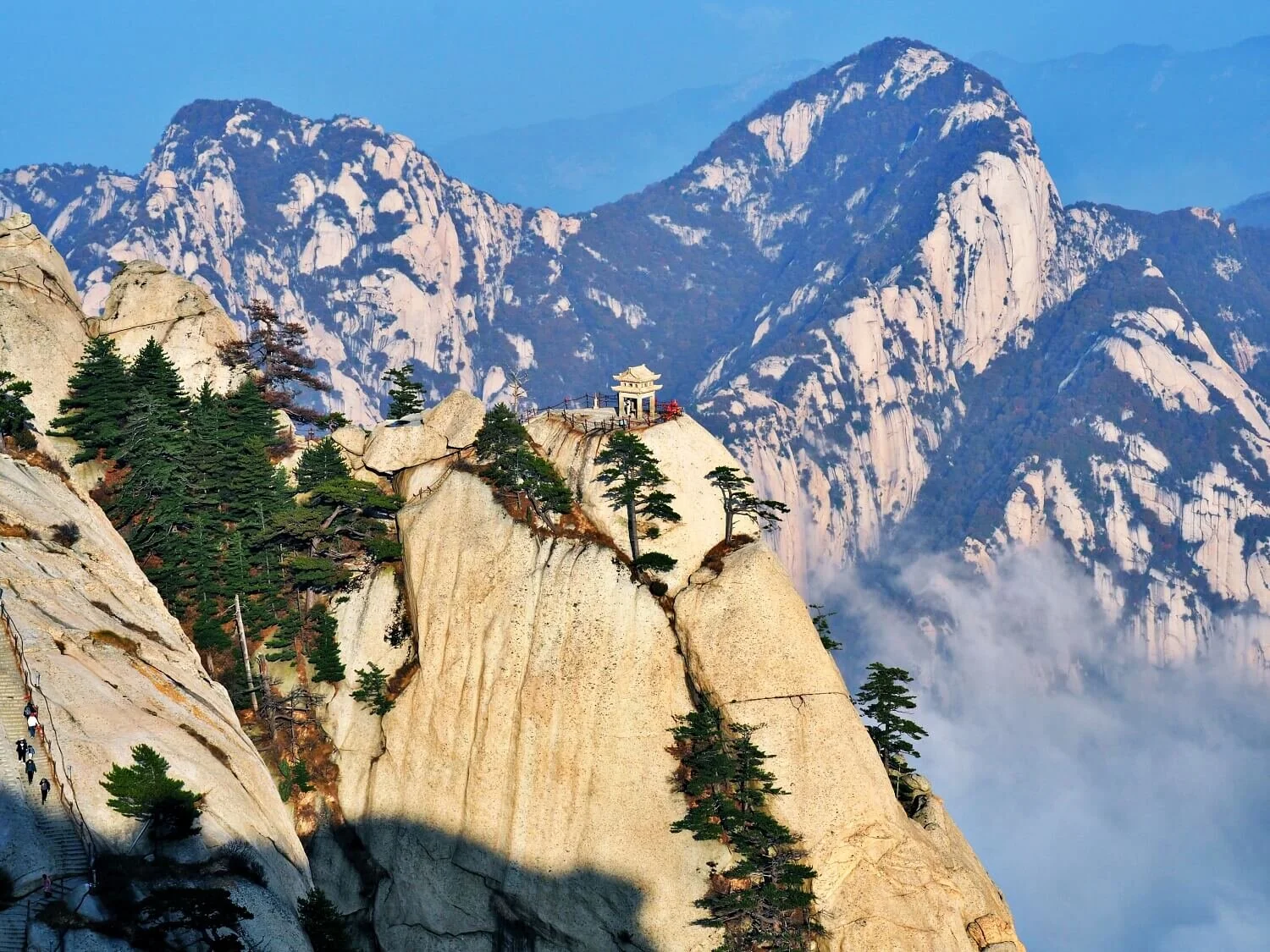China On the Cheap: Why You Should See Giant Pandas in Chengdu Without a Tour
Last updated March 2025
Hurray transparency! This post contains affiliate links. For more information see our disclosure.
A guide to visiting giant pandas in Chengdu independently. Even at this most popular of attractions, it is possible to get a little bit of time alone with these fluffy giants.
If you’ve already read my post on our initial impressions of China after two months in the country, you will know that one of the major learning curves for us was discovering that entrance fees at tourist attractions were hella pricey.
So it follows that going on tours anywhere in China is even MORE EXPENSIVE.
Why You Should See Giant Pandas in Chengdu Without a Tour
In China, we basically wanted to avoid tours at all costs. We just aren’t tour people. The idea of walking along in a line of tour zombies, doggedly following a flag on a stick as someone shouts into a microphone is basically our idea of hell. And paying for that ‘experience’? No thank you.
Most people visit giant pandas in China on a tour, perhaps because it requires less planning. We think this is a huge mistake, especially if you plan to visit Chengdu. If you are toying with the idea of paying for a Chengdu panda tour, here’s all the reasons why we think you shouldn’t:
Tours are damn expensive. A tour organised through our hotel - Chengdu Lazybones Hostel - to Chengdu Panda Base would have cost 150 yuan (£17) per person and included a hotel pick up and drop off.
This might not sound that expensive, but when compared to the normal £7 entrance fee to the giant panda base and £3 in a taxi to get there, you start to wonder where the extra cashish is going. And if you are travelling in a group, these costs start to add up.
This panda has mastered the Blue Steel look.
You can also book tours online, but these seem to be even more expensive: a half-day tour to the same centre on Viator started from $87 (£71)! Perhaps this rip off price is because that tour is apparently led by a professional panda keeper. Honestly, if I am going to pay 71 quid for this kind of tour, it better be led by the pandas themselves.
Note: Since I wrote this blog post, there seem to be more ‘reasonably’ priced tours to Chengdu Panda Base on Get Your Guide which cost around the same as what our hostel offered and also offer hotel pick up and drop off.
Mate, can you lead me on a tour?
Planning a last-minute trip to Chengdu? Let us help!
Best Chengdu Hotels:
Budget: Chengdu Lazybones Hostel (⭐ 8.8). This is where we stayed!
Mid-range: Wenjun Courtyard Hotel (⭐ 9.4)
Luxury: Niccolo Chengdu (⭐ 9.1)
Your experience with the pandas will feel rushed. Tours generally don’t allow anyone to linger, especially if there are multiple stops on the itinerary.
Most panda tours include other activities such as visiting nearby places of interest in Chengdu (such as Wenshu temple and Jinli street) or other major sights in the province like the Leshan Buddha.
So instead of being able to watch pandas rolling about for 20 minutes, you’ll be ushered from place to place, listening to someone yelling something about pandas into a microphone and then before you know it, you are back on the bus, heading to your next destination.
You’ll be there with mahoosive amounts of people. Okay, this is China, you can’t ever actually escape people (more on this later).
But if you are part of a huge coach tour, you are going to be with loads of people ALL THE TIME. That’s 50 odd people watching pandas with you. 50 people in all your photos. 50 selfie sticks. 50 people pushing and jostling to get a photo. Nope.
The tours are always out in force at Chengdu Panda Base. There were even more people behind me.
You waste a lot of time waiting when you could be seeing pandas. Boarding the coach at the end of your visit and then waiting 15 minutes for people to use the toilet.
Waiting for people to choose the perfect panda magnet from the gift shop. Waiting for the coach to drive all over Chengdu, picking up people from their various hotels before you even leave for the centre.
Waiting for people to finish their bloody hotel breakfast while you waste more of your life sitting on a coach.
All of this waiting means that you are sacrificing valuable panda viewing time.
How this panda feels about wasted panda viewing time.
Travelling already and wondering how to apply for your China visa? Check out our post on how to apply for your Chinese visa from Kuala Lumpur!
Still not convinced? Fine - below are the best tours of Chengdu Panda Base!
Giant Panda Breeding Research Base Ticket (⭐ 4.5/5)
Chengdu Panda Breeding Base Tour with Guide or Transfer (⭐ 5/5)
Chengdu: Giant Panda and Leshan Buddha Day Trip (⭐ 4.8/5)
The last tour is pricey, but it includes another attraction.
Where To See Pandas in China
Hopefully, by now, I’ve convinced you that you can see giant pandas without a tour. But where can you go to see them?
The best place to see pandas in China is undoubtedly in Sichuan province, as this is where you get to see them in their natural environment. There are four main places where you can go to see pandas in Sichuan:
Chengdu Research Base of Giant Panda Breeding - undoubtedly the most popular place to see pandas, given its location on the outskirts of Chengdu (around 40 minutes by car). The centre has 120 giant pandas (the largest number of any centre in Sichuan) and 76 red pandas.
A visit only takes half a day, so this is best for people who don’t have much time to spend in Chengdu. This is also the easiest place to do your own panda tour as it is easily accessible by public transport.
Dujiangyan Panda Base - around 1.5 hours from Chengdu, Dujiangyan has around 40 giant pandas and 5 red pandas. Visitors can see pandas here and also volunteer on a 1-day panda keeper programme (there are only 60 available spaces on this per day).
Dujiangyan Panda Base is accessible by public transport which can take around 1-2 hours.
Wolong Panda Centre - 30 pandas reside at this centre which is 121km west of Chengdu.
If you have time in your China itinerary, you can take two days out to visit Wolong: given the distance from Chengdu, it is likely to be a lot less crowded. As well as seeing the pandas and volunteering to take care of them, visitors can also go hiking and explore the surrounding forest.
It’s easiest to get to Wolong by private car (boo) but you can take a public bus there (yay!). They leave from the four main bus stations in Chengdu and the journey takes around 3 hours.
Bifengxia Giant Panda Base - if you have oodles of time, then this centre is the one to head to.
There are around 30-50 pandas at Bifengxia, which offers volunteer panda keeper programmes that last two or more days. Like Wolong, Bifengxia is pretty far out from Chengdu (150km in fact) and as a result gets fewer visitors.
If you want to see pandas without the crowds and also be surrounded by beautiful scenery with lots of opportunities for hiking, then this is the place to choose. There is a regular tourist bus that goes to Bifengxia Giant Panda Base and takes around 2 hours.
A Note About Volunteering at Panda Reserves and Holding Pandas in China
Three of the centres have volunteer programmes (Dujiangyan, Wolong and Bifengxia) but this requires some serious coin (starting from $250 for one day).
My long-held dreams of holding baby pandas in China (ever since I saw that baby panda sneeze video on YouTube) quickly evaporated when I realised:
A) they weren't doing it anymore at most places because they'd discovered that this could pass diseases on to the little ones and;
B) it was about $300 to hold any kind of panda for 30 secs...ARE YOU ON DRUGS?
Why are pandas so cute?
(There's also 'c' which are all the dubious ethical things involved with petting and cuddling basically wild animals but I will be the first to admit that I am an animal cuddler and I am attracted by some of these opportunities. Don't hate me. I am really trying to wean myself off.)
I’ve just read that there is a 2-day panda cub keeper programme and it costs…$999 per person. What. The. Actual. F@%k. Apparently this includes a 4-star hotel and an airconditioned business car. Good to know.
Given that we had two months to travel through China and it wasn't the cheapest place (I was surprised there wasn't an entrance fee to get into the 7/11 because they charged for everything else) we decided to give all this a pass.
Can You Really Beat the Crowds?
We decided to visit Chengdu Panda Base as it was the nearest reserve to our hostel and had the largest number of pandas out of all the reserves. Surely we’d have a chance of spotting at least one panda?
Trawling through the many Chengdu panda-related blogs we resolved to follow the advice and arrive early at the park so that we could ‘get ahead of some of the crowds’.
Tourist attractions in China are always a challenge because no matter where you go, there always seems to be a sea of people, armed with selfie sticks and mobile phones.
I'd read all the advice. “Go early”, one blog said, because then “you can avoid the crowds and be first in the ticket queue and first into the park”. “Get the shuttle bus to the furthest end of the park so that you can see the baby pandas first”, said another, “before everyone arrives”.
"We were so lucky to have the babies all to ourselves for an hour" gushed one tourist on TripAdvisor, "make sure you do what we did and arrive super early".
I am here to tell you Samuel L Jackson style that THIS IS BULLSH*t. You are in China. There are going to be the most epic crowds you have ever seen. You just have to learn to work with it.
Admittedly there are slightly fewer visitors in winter, which is when we visited. (I can’t even begin imagine what the crowds at Chengdu Panda Base would be like during peak season). Check out our guide on why winter is the best time to visit China (smaller crowds are one of the reasons!)
No crowds? I smell BULLSH*T!
How to get to Chengdu Research Base of Giant Panda Breeding
Option 1: Take a Didi
Chengdu Panda Base opens at 7:30am and so we got up early and took a Didi (the Chinese version of Uber) to the park. You can download an English version of Didi - the app is really easy to use and not glitchy. We always found the cars to be clean and the drivers were reliable.
We opted to take a Didi over using public transport as we usually would because it was less faffing around early in the morning and was pretty reasonable - 31 yuan (£3.50/$4.50) for a half an hour drive.
Chengdu Panda Base and Panda Avenue also come up on the Didi destination options, which makes everything much easier (no need to use a translation app or to get your hotel to write a note for you!).
You can add your credit card to Didi, use WeChat Pay/AliPay or pay the old fashioned way: in cash.
Option 2: By public transport
You can also take the metro to Panda Avenue station which is between 2 and 4 yuan (£0.20-$0.50, $0.30-$0.50) depending on where you are based and then from there take bus 198 or 198A (2 yuan/£0.20/$0.30) to the park.
What A DIY Tour At Chengdu Panda Base is Actually Like
Crazy queues
Arriving at the drop off point for taxis I was astonished to see crowds of people milling around. It was only 7:10am! And yet, there they were: heaving groups of domestic tourists, led by a tour leader armed with a flag and microphone, doing the zombie-shuffle towards the park entrance.
In the past, tour groups would arrive at the park at 9:00am, meaning that those who travelled independently could get there early and have the place to themselves for an hour and a half.
However, it quickly became clear that the best time to see the pandas was in the early morning as that is when they are most active and also when they are fed (which usually happens around 8:00am).
After many complaints from tourists about seeing pandas just sleeping in the late morning (something I really find hilarious - you aren't visiting a dancing bear circus for crying out loud), tour operators switched up their tactics and started arriving much earlier.
Hence this.
Buying Tickets to the Chengdu Research Base of Giant Panda Breeding
We made our way to the ticket office, expecting to find a huge queue there too but there were only two people in front of us - a Chinese mother with her daughter. Clearly tour groups can buy tickets in advance so they can go straight to the entrance.
While waiting for the office to open, we started chatting to the mum who told us they had arrived at 6:15am, hoping to be the first to enter the park, only to find that the ticket office opened at 7:30am and there were already crowds of people there. So arriving even earlier certainly wouldn't have helped us.
The ticket office opened promptly at 7:30am and we bought our tickets and followed our new friends into the queue.
This being China, we watched as they attempted to circumnavigate the huge queue by walking directly to the front (yep, here you gotta be brazen!) and when that failed they reluctantly joined the back and waited for the gates to open.
Adult tickets cost 58 yuan, around £6.60/$8.
Queuing: Chinese style
Once the gates opened it was every man for himself! People started pushing immediately and our mum and daughter team did not disappoint: they started to force their way to the front and beckoned for us to join them.
It was time to put British sensibilities aside: we got right in there behind them, elbows out, eyes steadfastly focused on the gate and made our way to the front of the queue.
Getting around the Chengdu Research Base of Giant Panda Breeding
Once inside the park, we weren't totally sure where to go but decided to follow the general direction of the tour groups as they seemed to know where they were going.
We also figured that if we walked really fast, we could probably burn off some of the slower moving tours and maybe endure fewer selfie sticks whilst watching the early morning antics of these cuddly-looking creatures.
Chengdu panda reserve covers quite a large area and most of the enclosures seem to be at the top of a hill. Contrary to what many tour operators will tell you however, it is definitely easy to navigate and you don't need a tour to take you all over the base.
Chengdu panda base is really easy to walk around.
There is a shuttle bus that can drive you all around the park, if you don't want to walk or cannot walk. However, it only starts operating at 8.00am (a bit late and contrary to many Trip Advisor reviews won't help you beat the crowds if you arrive early) and costs 10 yuan (£1/$1.50) per person.
Do yourself a favour and avoid this shuttle bus craziness.
The queues for it later on in the morning are absolutely insane though - by the time you’ve queued and waited for it to arrive, you’ll have passed four Christmases and Godot will have been and gone (geddit?!). You are definitely better off walking.
A Crazy Panda-Related Race
What we hadn't accounted for however, was people actually running. Yes, you've read that correctly. As we speed-walked past three tour groups, we came across the runners: people so desperate to be the first to catch a glimpse of the pandas that they were running. Every few metres they would sprint, then stop for a few seconds to catch their breath and then sprint again.
The pandas trying to get a good view of the race.
I was in awe of this level of dedication - I thought we were trying hard to have a good panda viewing experience but to see a girl dressed in a beret, leather mini skirt and knee-high boots with three-inch heels actually sprinting up the hill (when she looked like she should have been in a French perfume ad) was seriously impressive.
Which Enclosure To Visit First?
The No.2 Giant Panda Enclosure
Honestly, there isn’t a hard and fast rule about what order to see the pandas in. Our advice would basically be to avoid where the tour groups are going and you should be fine.
After a bit of speed walking, we eventually came to a sort of junction - in one direction was the 'No.2 Giant Panda' enclosure and in the other were the Moonlight and Sunlight Panda Nurseries. It suddenly dawned on us what the running and crowds of people had come here for: to see the baby pandas first, just like the reviews on Trip Advisor had mentioned.
The baby pandas are what EVERYONE wants to see.
By this point, I had had enough of this circus. I looked at Vincent and by a process of what appeared to be telepathy, we decided to veer off towards the No.2 enclosure behind another couple.
As we walked into the area, we were greeted by the sight of two pandas gambolling about and play-fighting.
Now, this was what we had come for: the chance to get to see these animals up close, eating, playing and rolling about, made the whole madness of the experience completely worthwhile.
And the best bit was that there were just four of us watching these animals doing their morning activities (which appeared to consist of chomping on bamboo, chasing each other and just chilling).
There was no pushing. We could just relax. After about ten minutes the other couple left and it was just us, a security guard and the pandas.
Half an hour later we wandered out of the enclosure and came upon a lone male panda sitting really close to the fence, greedily feasting on a pile of bamboo.
Again we were alone and watched him really quietly for about 10 minutes before being joined by a small group of visitors.
The Sunlight and Moonlight Nurseries
We went back out onto the main road to decide what to do next.
Feeling like we had experienced some decent enough panda moments, we worked up the courage to visit the Sunlight and Moonlight nurseries, assuming that they would probably be as mental (if not more so) as they were in the morning.
Pandas love a bit of morning play time.
The Sunlight nursery had an outdoor section for older cubs - we saw three playing with each other, climbing up and down trees and on to branches (which really didn't seem capable of taking their weight) and generally just being absolutely adorable and cute.
The crowds weren't so bad here - there were about 30 people when we arrived although more people started to join as we watched the panda cubs.
Can pandas climb trees? The answer is YES.
The actual nursery section of the Sunlight area was another matter. People jostled and shoved to get close to the window of the nursery which housed two young cubs (I estimated the equivalent of a one-year-old human toddler). A guard blew his whistle to no avail: no one was listening.
So. Damn. Adorable.
The cubs wandered about exploring their enclosure, thankfully oblivious to the faces, arms and sometimes legs smooshed up against the window of their nursery.
It was here that I learned that older Chinese people have got pushing down to a fine art: either leaning on you until you are forced to step aside or using a well-placed elbow to sneak their way in front of you.
“How shall we make our escape?”
A man who looked about 80 tried the double whammy on me - the leaning combined with a pointy elbow shoved into my arm.
Having just about made it to the window and not really in the mood to show respect to my elders (especially one like this!), I squatted and made a sort of frame with my arms. I then gave him a big wide smile. He could push as much as he liked, I wasn't going anywhere.
I later discovered that a woman had leant on Vincent, in an attempt to push him aside and he had simply stepped back resulting in her falling over. Whoops.
The queue at the Moonlight nursery was far more orderly. Firstly, you see I mention a queue: as in, there actually was one. Everyone lined up and slowly filed past a window where we could see a tiny baby panda sleeping surrounded by lots of blankets.
There was a small amount of time where you could snap a few pictures and then the security guards shouted at you to move on (again hilarious because there were signs everywhere telling you not to make noise).
We stopped by the red pandas and enclosure No.1 which, like No.2 also houses adult pandas, on our way back to the entrance.
The red panda house was quiet (sorry guys you are cute but you aren't the main attraction here) and enclosure No.1, although busy, was not too crazy despite it being 11:00am.
I had plenty of time and space to get some lovely close up panda photos, which was great because the light was now a bit brighter too.
All in all our visit took about 3 and a half hours and apart from the initial speed walk from the gate right at the beginning, we were relaxed and took our time.
What else is there to see at Chengdu Giant Panda Research Base?
There are a couple of other attractions at the Chengdu panda research center, so if you don’t need to rush off you can linger in the area a bit longer. These include:
Panda Story Cinema. A short film about the panda base is played on a loop - it gives you background information about the animals and also how the reserve works to save them from extinction.
The Panda Discovery Center. Basically a panda-themed interactive exhibition. There are lots of touch screens and other activities that give you information about the pandas, covering everything from breeding and genetics to nutrition.
Other Museums. There are a couple of museums in the centre - the map might show them as ‘old’ and ‘new’. The new museum apparently has virtual reality technology where you can feel like you're touching a real panda. Seeing the pandas with my own eyes was enough for me, but this could be a replacement to the $300 panda cuddling experience.
Swan Lake. A pretty picnic area with a lake and swans. Perhaps a good break after being elbowed and shoved in the Sunlight nursery.
Gift shop and post office. If you want a panda magnet, this is the place to get it. The panda post office sells postcards with commemorative stamps and there’s a panda post box too. They’ll send your postcard to anywhere in the world.
Are there restaurants and cafes at the Chengdu Giant Panda Breeding Center?
We’d eaten our usual dirt-cheap breakfast of oats and yogurt in our hotel room before we left for the centre (depressing but definitely a money and time saver), so we didn’t eat during our visit. There are a few restaurants around the centre, but I am not sure whether these open during the morning.
If you are starving, an option is to bring your cup noodles and use the free hot water in the tourist service centre located on the first floor of the Giant Panda Museum. There’s apparently a microwave in there too, so maybe you could bring along a full meal!
Where to stay in Chengdu?
Hostels in China are the bomb and even if you aren’t travelling on a budget as we were, we’d still recommend you stay in at least one.
Hostels are one of the places that you definitely get value for money in China!
We stayed at Chengdu Lazybones Hostel which was clean, comfortable, with helpful staff and reasonably priced food. We stayed in a private double room with an ensuite bathroom but there are dorm rooms available as well.
Tips on Seeing the Giant Pandas at Chengdu Panda Base
• It is worth going early to the Chengdu panda center and buying your ticket at 7.30am even though you won't be able to avoid the queues this way. The pandas are fed at 8am so from 7.30 to around 11am they are at their most active. If you don't mind seeing sleeping pandas, you can visit later than this.
• Consider visiting the adult pandas first. The babies/young cubs will always be the most popular and from our experience will be crowded whatever time you go there. Whilst the adult panda enclosures won't always be crowd-free (remember you are in China!) it might be less crowded and a more enjoyable experience. Plus these adults need some love too.
• Remember that there aren't always baby pandas. Pandas usually give birth in August so if seeing baby pandas in Chengdu is your dream thang, time your visit for August or September.
Summary of Costs of Visiting Chengdu Panda Base
Adult tickets cost 58 yuan (£7/$8). Children’s tickets are 27 (£3/$4) yuan.
A ticket on the metro to Panda Avenue will cost between 2-4yuan (£0.20-$0.50, $0.30-$0.50) depending on where you are staying. Once at Panda Avenue you can take bus 198 or 198A to the giant panda research base at a cost of 2 yuan (£0.20/$0.30).
A regular taxi directly to the panda center in Chengdu can cost between 50-70 (£6-£8, $7-$10) yuan depending on traffic. If you are choosing this option, remember to ask your hotel to write down where you are going on a piece of paper that you can give to the driver as most don’t speak English.
Taking a Didi is much cheaper than a taxi and cost us only 31 yuan (£3.50/$4.50).
It was far more convenient than the metro, which was 15 minutes walk away from our hostel. Definitely consider this option if you are travelling in a group as it is less faff than taking the metro (unless you are super close to a metro station) and also works out at the same price if there are a few of you.
Have you seen pandas in China? Where do you think is the best place to see them?
Looking for more travel inspiration? Click here to discover more of our favourite places around the world
If you liked this article Pin it!
Some of the links in this Chengdu Panda Base guide are affiliate links.
That means that if you drop any ca$h monies on any products after clicking one of these links (i.e. make a purchase), we will earn a small commission at no extra cost to you. This enables us to MAKE IT RAIN, BABY, (nah just kidding, we actually use it to buy coffee which we drink whilst creating more useful and entertaining content like this).
Mog and Dog Travels is a participant in the Amazon Services LLC Associates Program. As an Amazon Associate I earn from qualifying purchases.
Don’t worry, we only link to places that we really like and products that we actually own or would buy for ourselves.
